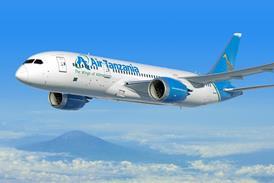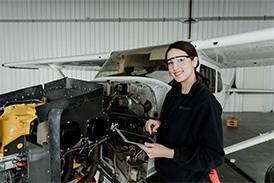Tom O’Leary concedes that most suppliers were sceptical when his start-up, JetZero, approached them a couple of years ago with a business plan to challenge Airbus and Boeing with a bold new commercial aircraft design.
The concept calls for a blended wing-body (BWB) aircraft, also known as an “all-wing” airframe, large enough to carry 200-250 passengers.
Building off decades of research on the flight characteristics of BWB aircraft, JetZero’s “Z4” features a less-distinct fuselage that blends into a broad wingspan with upswept winglets, and two turbofans mounted atop a relatively short body.
JetZero intends to build the aircraft with materials, parts, components and engines already in use, leaning on aerospace manufacturers with established supply chains.
But O’Leary, the company’s founding chief executive, told reporters this month at JetZero’s facilities at Long Beach airport that getting suppliers to buy into the idea was initially challenging.
“Naturally, their answer was ‘no way,’” he says. “We were looking at our vision and they were looking back at us and saying, ‘What are you guys like, eight people? You do realise there’s a global duopoly, right?’”
Building a large, radically different-looking composite airframe at scale to compete against the world’s leading aerospace manufacturers, O’Leary says, is “daunting but not impossible”.
Sky-high development costs, which by some estimates could reach $10 billion, are among many considerations that come with building the world’s first BWB airliner.
But JetZero believes demand for Z4 will be massive. The future, it maintains, is all-wing.

The rapidly growing Los Angeles-area start-up has been creating buzz within the industry since landing in August 2023 a $235 million contract with the US Air Force (USAF) to build a full-scale demonstrator, with the goal of achieving first flight in 2027.
More recently, United Airlines became the latest US carrier to throw support behind the BWB aircraft’s development with a conditional order for up to 200 jets, contingent on Z4 hitting certain development milestones. United has invested in JetZero, though it does not disclose a dollar amount.
The start-up is also partnering with Delta Air Lines to study cabin layouts enabled by the BWB airframe, and it received financial backing from Alaska Airlines in a Series A funding round that closed in 2023.
Founder and chief technology officer Mark Page tells FlightGlobal that JetZero has engaged in deep talks with Delta – including about route planning with Z4 – but the Atlanta-headquartered airline has thus far balked at financially supporting JetZero.
Page expresses confidence that the relationship between JetZero and Delta will advance, however.
It remains to be seen how JetZero will raise the billions of dollars required to bring Z4 to market, though it hinted at pursuing public-private partnerships and private equity fundraising that could provide infusions of cash, in addition to securing pre-orders from airlines.
Scott Savian, JetZero’s head of product, tells FlightGlobal the company is continually engaging in talks with potential airline customers. In addition to major US carriers, he says, cargo carriers, lessors and low-cost passenger airlines are among those interested in Z4.
Beyond carrying passengers and cargo, the all-wing aircraft has potential military transport and aerial refuelling applications.
“Every time we’re laying out the interior and exterior of the plane, we’re looking at the multiple functionality of the aircraft,” Savian says.
O’Leary emphasises that the USAF demonstrator will support JetZero’s commercial aircraft programme, and that there are “zero military requirements” aside from demonstrating to the USAF the viability of the airframe.
“Once that happens, then the air force and other military operations could really just deploy it as a derivative,” he says. He points to examples such as the Boeing KC-46 aerial refuelling tanker, a derivative of the 767.
JetZero calls its tanker concept the KC-Z4.
While the company says it is laser-focused on the commercial market, landing the USAF contract marked the turning point when suppliers started taking the programme more seriously, according to O’Leary. “Everyone on the military side started working with our team and referring us back over the fence to the commercial side.”
‘LIMITS’ OF GEOMETRY
There is a belief within the company that the efficiency of the traditional tube-and-wing airliner design is more or less maxed out, with almost all potential aerodynamic gains already achieved.
“We’re at the limits of the current geometry,” Savian says. “Changing geometry is way easier than changing physics.”
O’Leary adds that the flying public has only ever known one aircraft design, and that an alternative is long overdue.
“We’ve been flying on the same configuration of aircraft for, well, our whole lifetime, right? Since really the ‘50s and ‘60s, we got this tube-and-wing configuration which served us well,” O’Leary says. ”It allowed us to expand global air travel. Really, the modern world would not be what it is today, it would just be wholly different, if it weren’t for this form of air travel.”
However, O’Leary asserts that the tube-and-wing has “long-since passed the point of diminishing returns”, while the Z4’s superior lift and aerodynamics will allow it to rise above conventional airframes.
“The all-wing design effectively brings lift across the entire wing and harnesses the four forces of flight — lift, weight, drag and thrust – and brings them into a kind of virtuous cycle, where a lifting body and lower drag and lower weight through carbon composites means that you need less of an engine, and a smaller engine means less weight and also less drag,” he says.

JetZero estimates this “virtuous cycle” will cut Z4’s fuel burn by up to 50% over today’s airliners, representing the efficiency leap that the global airline industry needs to significantly cut pollution and approach an increasingly distant-seeming target of “net zero” emissions by 2050.
“That’s really the beauty of it, that this one single technology does so much,” O’Leary says.
The jet passed a preliminary design review milestone in 2024, with a critical design review expected to be completed this year, followed by an expected systems integration review in 2026.
JetZero maintains it is on track to fly its full-scale demonstrator in 2027.
‘MASSIVE’ MARKET
Z4 will be aimed at what JetZero identifies as an underserved segment of the airliner market – aircraft with 200-250 seats, a niche long filled by the now-ageing Boeing 757. Notably, the most-stretched variants of current narrowbody platforms – the Airbus A321XLR and Boeing 737 Max 10 – fall into this market segment.
Airbus is currently ramping production of the newly certificated A321XLR, while Boeing has yet to clear certification of the much-delayed 737 Max 10.
Savian says JetZero is moving into a “massive market in desperate need of a new technology”.
“This is right where the airlines say they need the planes,” O’Leary says. “We believe that the demand here through 2050 is going to be really more planes than we could ever build.”
Some within the company expect Airbus and Boeing will focus for years on filling orders for thousands of current-generation narrowbody jets, and not on bringing new airliner designs to market.
JetZero team members also suggest that major airframers will pursue BWB concepts of their own once the concept is proven a winner.
“I think we’re a good thing for the industry,” Savian says. “When we succeed, I do believe that it will compel others to follow.”
The start-up intends to produce hundreds of jets annually by the mid-2030s.
O’Leary acknowledges that production rates have historically been lower for all-composite aircraft, and that accelerating production rates of large composite airframes is a “goal for the factory of the future”.
To that end, JetZero plans to build a manufacturing facility somewhere in the USA with a “SoFi Stadium complex, Magic Kingdom”-sized footprint, O’Leary says. “This is a massive, 1,000-acre type of an operation.”
JetZero intends to handle composite manufacturing and fuselage assembly mostly in-house, increasing the required footprint of the company’s envisioned production plant. A site for the factory has yet to be revealed.
’SHOULDERS OF GIANTS’
JetZero envisions itself introducing disruptive technology into the deeply entrenched aerospace manufacturing industry, with O’Leary making comparisons to such start-ups as SpaceX, Palantir and Waymo.
“These companies are coming into a space and saying, ‘There’s a better way’. And usually what’s involved is that you set aside your pre-conceptions – sometimes misconceptions – about what it takes to bring a new technology to market,” he says. “Everything we’re doing here at JetZero is designed to lower the barrier to entry.”
O’Leary himself previously worked at Tesla, while JetZero has attracted talent from the likes of Airbus, Boeing, Embraer, Gulfstream and electric aircraft developer Beta Technologies.
Chief commercial officer Dan Da Silva, a former Boeing executive and the son of an Embraer founder, says the common force animating JetZero’s employees is “an interest in bringing something different to this market”.
The team is “familiar with the art of disruption”, O’Leary says.
But he notes JetZero is not pursuing a Tesla-type strategy of vertical integration, choosing rather to work with established aerospace suppliers to reduce the project’s risk.
“What we decided from the very beginning was… [to] build on the shoulders of giants,” O’Leary says, pointing to flight-test data collected from previous BWB designs.
“What a phenomenal thing to be able to start a company on the back of… a billion dollars in research across decades with the world’s experts,” he adds.

BWB technology has been studied for decades, with McDonnell Douglas developing a concept in the 1990s and NASA and Boeing later collaborating on the X-48 programme, which saw the assembly and test flights of two sub-scale prototypes from 2007-2013.
More recently, trace elements of BWB design appeared in NASA and Boeing’s conceptual design for a transonic truss-braced wing aircraft known as the X-66. That concept was recently abandoned by Boeing, which is now studying “thin-wing” technology for its next commercial jet.
While the BWB design has established aerodynamic advantages, it also has known drawbacks.
Chief among them is pitch stability. Because BWB aircraft lack horizontal stabilisers, they require active correction from flight-control surfaces to balance loads, introducing complexity.
Predecessor designs have also shown poor low-speed handling during take-off and landing.
Da Silva says JetZero is testing the aircraft’s aerodynamics using truck-mounted subscale models. It will lock in its prototype design when “we are satisfied with the controllability at every stage of flight”.
”Once we’ve achieved… 15-20 flights at every angle of attack, every slip angle… all in perfect condition and repeatable, then we know we have a stable architecture,” he says.
JetZero is not the only start-up seeking to bring BWB aircraft to market and disrupt decades of tube-and-wing dominance. San Diego-based Natilus is currently searching for a US manufacturing site to build its autonomous Kona cargo aircraft, and eventually a larger 200-passenger jet called Horizon.
Canadian business jet manufacturer Bombardier has also been studying a BWB design with its EcoJet programme.
While aware of Natilus and its similarly big ambitions, Savian says JetZero is focused on its own development pathway.
“We kind of have our eye on the prize,” he says, ”which is to deliver the first all-wing aircraft and do it in the right place in the market with a complete product offering.”































